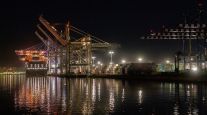CEO, Ladingo
Perspective: Green Shipping on the Big Blue Sea
[Stay on top of transportation news: Get TTNews in your inbox.]
Carriers that operate in the intermodal space have a lot to consider when it comes to selecting shipping partners. Usually, the candidate’s commitment to battling climate change isn’t the first thing that comes to mind. But that reality is beginning to change, as some shipping companies have already taken steps to adapt to rising sea levels and make themselves greener. Going forward, some new ideas on the horizon give sea freight the potential to become an even more environmentally friendly sector, giving companies seeking shipping partners a lot to consider.
Many of these ideas center on tweaking technology as it exists today in ways that would save on fuel and emit less carbon. Changing hull paint, for example, can cut fuel consumption. That’s because seaweed, barnacles, mussels, oysters and tubeworms are all attracted to ship hulls. When they attach themselves to hulls, it increases the friction drag on the ship and, as a result, the amount of fuel a ship needs to cut through the water. Self-polishing anti-fouling paints produce a smoother hull surface that keeps such nuisances away, preventing subaquatic organisms from attaching to the hull and enabling the ship to move faster.
Another simple carbon-cutting approach is to provide power to docked ships by plugging them into an electric grid. Otherwise known as Alternative Maritime Power, or dock-side power, it could turn out to be shipping’s ace in the hole against climate change. It’s already attracting some interesting measures, as the city of Oslo, Norway, plans to make use of AMP as a part of its effort to make its port the world’s first zero-emissions port and slash carbon emissions by 85% by 2030. Certain details of the plan remain unclear, including how the city will successfully incentivize shippers to participate in AMP. But what is clear is this plan to reduce emissions to zero is moving forward at full speed.

Valiano-Rips
There are other ports around the world, including Los Angeles, Auckland, New Zealand, and Valencia, Spain, that also plan to drastically cut their emissions to zero. Los Angeles, for example, is working to transition all cargo-handling equipment on its port’s docks to zero-emission vehicles by 2030, in an agreement with the city of Long Beach. The agreement between the two cities calls for their ports to reduce greenhouse gas emissions to 40% below 1990 levels by 2030 and 80% below 1990 levels by 2050. Los Angeles also makes use of AMP.
There also are innovative updates to older technology. Ocean carrier A.P. Moller-Maersk A/S, for example, is working on an evolution of principles used by old-fashioned sails in the modern shipping industry. Known as rotor sails, these 98-foot-tall cylinders work by spinning and rotating. They drag air faster around one side when spinning, creating a difference in pressure that pushes the vessel in the direction of lower pressure. The company conducted a successful trial of the technology, made by Norsepower Oy Ltd., on one of its giant tankers. Norsepower predicts the modern-day sails could harness enough wind to replace 20% of the ship’s fossil fuels.
Regulation also is affecting the shipping industry’s environmental impact. Starting this year, the International Maritime Organization adopted a policy that requires ships to drastically reduce the sulfur content of the fuel they burn. The measure was aimed at supporting greenhouse gas-reduction objectives set out in the UN Paris Climate Change Agreement.
The effort to go green also is fueled by economic incentives, as fuel accounts for a large chunk of the total cost in shipping. Industry observers can expect to see a diversification of the fuel mix in coming years, along with expanded adoption of alternative fuels, such as liquefied natural gas, liquefied petroleum gas, hydrogen and methanol. This effort will be coupled with a rise in the use of scrubbers, or exhaust gas cleaning systems, which essentially remove harmful components from the exhaust gas produced by ships to cut down on sulfur.
For carriers and other companies in the transportation industry that are seeking ways to cut emissions, or just generally get a little greener, innovations and regulations in shipping are worth following.
Just as environmental protection regulations have come to shape other major industries, business executives in shipping know that they will have to adapt to survive — and the sooner the better. The industry as a whole needs to work together, and shipping has a part to play.
Hagar Valiano-Rips is the CEO of Ladingo, and an entrepreneur and dynamic professional with more than 14 years of executive experience in business and product development across internet industries.
Want more news? Listen to today's daily briefing:




